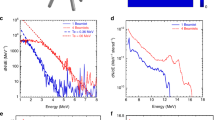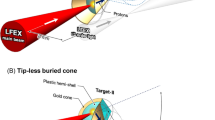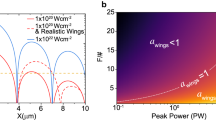Abstract
Attraction and fusion between co-propagating light beams, mutually coherent or not, can take place in nonlinear media as a result of the beam power modifying the refractive index of the medium. In the context of high-power light beams, induced modifications of the beam patterns could potentially impact many topics, including long-range laser propagation, the study of astrophysical colliding blast waves and inertial confinement fusion. Here, through experiments and simulations, we show that in a fully ionized plasma, which is a nonlinear medium, beam merging can take place for high-power and mutually incoherent beams that are initially separated by several beam diameters. This is in contrast to the usual assumption that this type of interaction is limited to beams separated by only one beam diameter. This effect, which is orders of magnitude more significant than Kerr-like nonlinearity in gases, demonstrates the importance of potential cross-talk amongst multiple beams in plasma.
This is a preview of subscription content, access via your institution
Access options
Subscribe to this journal
Receive 12 print issues and online access
$209.00 per year
only $17.42 per issue
Buy this article
- Purchase on Springer Link
- Instant access to full article PDF
Prices may be subject to local taxes which are calculated during checkout






Similar content being viewed by others
References
Stegeman, G. & Segev, M. Optical spatial solitons and their interactions: Universality and diversity. Science 286, 1518–1523 (1999).
Meng, H., Salamo, G., Shih, M. & Segev, M. Coherent collisions of photorefractive solitons. Opt. Lett. 22, 448–450 (1997).
Krolikowski, W. & Holmstrom, S. Fusion and birth of spatial solitons upon collision. Opt. Lett. 22, 369–371 (1997).
Shih, M. & Segev, M. Incoherent collisions between two-dimensional bright steady-state photorefractive spatial screening solitons. Opt. Lett. 21, 1538–1540 (1996).
Synder, A. W. & Mitchell, D. J. Accessible solitons. Science 276, 1538–1541 (1997).
Rotschild, C., Alfassi, B., Cohen, C. & Segev, M. Long-range interactions between optical solitons. Nature Phys. 2, 769–774 (2006).
Tzortzakis, S. et al. Breakup and fusion of self-guided femtosecond light pulses in air. Phys. Rev. Lett. 86, 5470–5473 (2001).
Xi, T. et al. Interaction of light filaments generated by femtosecond laser pulses in air. Phys. Rev. Lett. 96, 025003 (2006).
Kruer, W. Ponderomotive and thermal filamentation of laser light. Comments Plasma. Phys. Control. Fusion 9, 63–72 (1985).
Tikhonchuk, V. T. et al. Stimulated Brillouin and Raman scattering from a randomized laser beam in large inhomogeneous collisional plasmas. II. Model description and comparison with experiments. Phys. Plasmas 8, 1636–1649 (2001).
Rose, H. A. & DuBois, D. F. Laser hot spots and the breakdown of linear instability theory with application to stimulated Brillouin scattering. Phys. Rev. Lett. 72, 2883–2886 (1994).
Hüller, S. et al. Interaction of two neighboring laser beams taking into account the effects of plasma hydrodynamics. Phys. Plasmas 4, 2670–2680 (1997).
Ren, C. et al. On the mutual interaction between laser beams in plasmas. Phys. Plasmas 9, 2354–2363 (2002).
Shukla, P. et al. Instability and dynamics of two nonlinearly coupled laser beams in a plasma. Phys. Plasmas 13, 053104 (2006).
Williams, E. On the control of filamentation of intense laser beams propagating in underdense plasma. Phys. Plasmas 13, 056310 (2006).
Wattellier, B. et al. Generation of a single hot spot by use of a deformable mirror and study of its propagation in an underdense plasma. J. Opt. Soc. Am. B 20, 1632–1642 (2003).
Young, P. et al. Observations of laser-beam bending due to transverse plasma flow. Phys. Rev. Lett. 81, 1425–1428 (1998).
Montgomery, D. et al. Flow-induced beam steering in a single laser hot spot. Phys. Rev. Lett. 84, 678–681 (2000).
Labaune, C. et al. Laser-plasma interaction in the context of inertial fusion: Experiments and modelling. Eur. Phys. J. D 44, 283–288 (2007).
Glenzer, S. et al. Experiments and multiscale simulations of laser propagation through ignition-scale plasmas. Nature Phys. 3, 716–719 (2007).
Denavit, J. & Phillion, D. W. Laser ionization and heating of gas targets for long-scale-length instability experiments. Phys. Plasmas 1, 1971–1984 (1994).
de Wispelaere, E. et al. Formation of plasma channels in the interaction of a nanosecond laser pulse at moderate intensities with helium gas jets. Phys. Rev. E 59, 7110–7120 (1999).
Malka, V. et al. Strong self-focusing in quasi-stationary laser plasmas. Phys. Plasmas 7, 4259–4265 (2000).
Valeo, E. J. & Estabrook, K. G. Stability of the critical surface in irradiated plasma. Phys. Rev. Lett. 34, 1008–1011 (1975).
Pesme, D. et al. Resonant instability of laser filaments in a plasma. Phys. Rev. Lett. 84, 278–281 (2000).
Michel, P. et al. Studies of the laser filament instability in a semicollisional plasma. Phys. Plasmas 7, 3545–3553 (2003).
Myatt, J. et al. Nonlinear propagation of a randomized laser beam through an expanding plasma. Phys. Rev. Lett. 87, 255003 (2001).
Johnson, L. & Chu, T. Measurements of electron density evolution and beam self-focusing in a laser-produced plasma. Phys. Rev. Lett. 32, 517–520 (1974).
Fuchs, J. et al. Experimental evidence of plasma-induced incoherence of an intense laser beam propagating in an underdense plasma. Phys. Rev. Lett. 86, 432–435 (2001).
Epperlein, E. M. Kinetic theory of laser filamentation in plasmas. Phys. Rev. Lett. 65, 2145–2148 (1990).
Epperlein, E. M. & Short, R. W. Nonlocal heat transport effects on the filamentation of light in plasmas. Phys. Fluids B 4, 2211–2216 (1992).
Berger, R. L., Valeo, E. J. & Brunner, S. The transition from thermally driven to ponderomotively driven stimulated Brillouin scattering and filamentation of light in plasma. Phys. Plasmas 12, 062508 (2005).
Chessa, P. et al. Temporal and angular resolution of the ionization-induced refraction of a short laser pulse in helium gas. Phys. Rev. Lett. 82, 552–555 (1999).
Mitchell, M., Chen, Z., Shih, M. & Segev, M. Self-trapping of partially spatially incoherent light. Phys. Rev. Lett. 77, 490–493 (1996).
Kruer, W. L. Nonlinear estimates of Brillouin scatter in plasma. Phys. Fluids 23, 1273–1275 (1980).
Pesme, D. et al. Laser–plasma interaction studies in the context of megajoule lasers for inertial fusion. Plasma Phys. Control. Fusion 44, B53–B67 (2002).
Atzeni, S. & Meyer-ter-Vehn, J. The Physics of Inertial Fusion (Oxford Univ. Press, 2009).
Kodama, R. et al. Development of a two-dimensional space-resolved high speed sampling camera. Rev. Sci. Inst. 70, 625–628 (1999).
Maire, P-H., Abgrall, R., Breil, J. & Ovadia, J. A cell-centered Lagrangian scheme for two-dimensional compressible flow problems. SIAM J. Sci. Comput. 29, 1781–1824 (2007).
Breil, J. & Maire, P-H. A cell-centred diffusion scheme on two-dimensional unstructured meshes. J. Comput. Phys. 224, 785–823 (2007).
Schurtz, G. et al. Revisiting nonlocal electron-energy transport in inertial-fusion conditions. Phys. Rev. Lett. 98, 095002 (2007).
Acknowledgements
We acknowledge the support of the LULI teams and discussions with F. Amiranoff, L. Bergé, S. N. Chen, S. Hüller, M. Grech, S. Weber, J. P. Zou and Y. Sakawa. This work was supported by grant E1127 from Région Ile-de-France and by the CEA-EURATOM association as an IFE ‘keep-in-touch’ activity and by the Marie-Curie Actions programme from the EU community. M.N. was partially supported by JSPS Postdoctoral Fellowships for Research Abroad.
Author information
Authors and Affiliations
Contributions
M.N. (on leave from Osaka University, supervised by R.K.), J-R.M., P. Antici, N.B., T.L., L.R. and J.F. carried out the experiments, M.N., J-R.M. and J.F. analysed the data and wrote the paper with discussions with R.K. and P. Audebert, J.L.F. and P.N. carried out the numerical simulations, J.F. planned the project.
Corresponding author
Ethics declarations
Competing interests
The authors declare no competing financial interests.
Supplementary information
Supplementary Information
Supplementary Information (AVI 695 kb)
Supplementary Information
Supplementary Information (AVI 886 kb)
Supplementary Information
Supplementary Information (AVI 1425 kb)
Supplementary Information
Supplementary Information (AVI 720 kb)
Rights and permissions
About this article
Cite this article
Nakatsutsumi, M., Marquès, JR., Antici, P. et al. High-power laser delocalization in plasmas leading to long-range beam merging. Nature Phys 6, 1010–1016 (2010). https://doi.org/10.1038/nphys1788
Received:
Accepted:
Published:
Issue Date:
DOI: https://doi.org/10.1038/nphys1788



